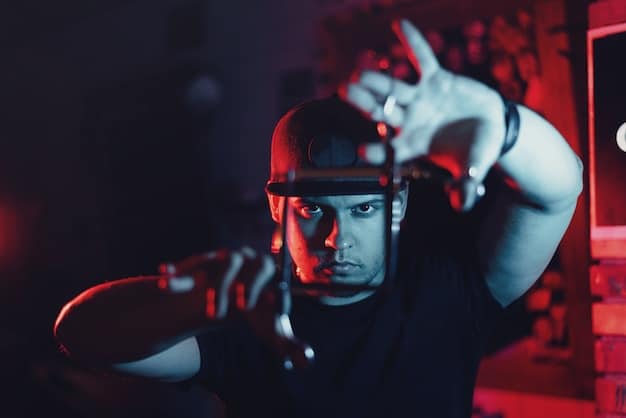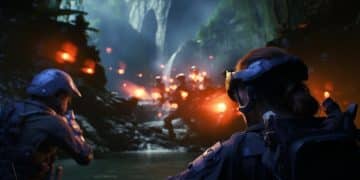Wild Rift Esports: Top 3 NA Tournament Team Compositions Predicted

Predicting the top 3 team compositions for the upcoming Wild Rift Esports NA Regional Tournament requires analyzing current meta trends, champion synergies, and team strategies, highlighting compositions that balance early game pressure with late-game scaling for optimal success.
As the North American Wild Rift Esports scene gears up for its highly anticipated regional tournament, analysts and fans alike are buzzing with predictions. One of the most exciting aspects of any MOBA tournament is speculating which team compositions will dominate the meta. Let’s dive into a data-backed exploration, predicting the top 3 team compositions that could shape the outcome of the upcoming **Wild Rift Esports: Predicting the Top 3 Team Compositions for the Upcoming NA Regional Tournament**.
Analyzing the Current Meta
Understanding the current meta is crucial before diving into specific team compositions. The ever-evolving nature of Wild Rift means that strategies and champion picks are constantly being refined. Key factors influencing the meta include recent patch updates, champion buffs and nerfs, and the rise of innovative playstyles.
Currently, we’re seeing a strong emphasis on early-game aggression and objective control. Teams are prioritizing champions that can secure early leads and snowball advantages. However, late-game scaling and team fight potential remain critical components for a well-rounded composition.
Key Champion Trends
Several champions have emerged as consistent picks and bans in the current competitive scene.
- Kha’Zix: A dominant jungler known for his ability to assassinate high-priority targets.
- Orianna: A versatile mid-laner offering excellent wave clear, poke, and team fight control.
- Camille: A strong solo laner capable of split-pushing and engaging in skirmishes.

Strategic Shifts in Gameplay
Beyond individual champion picks, strategic approaches are also shaping the meta. Teams are increasingly focusing on:
- Early Invades: Aggressive early-game strategies to disrupt the enemy jungler and secure vision control.
- Objective Focus: Prioritizing dragons and Rift Herald to gain significant buffs and map control.
- Rotations and Split-Pushing: Coordinating rotations to pressure different lanes and create opportunities for split-pushing.
In conclusion, the current meta favors proactive plays, early objective control, and well-rounded team compositions that can adapt to different game states. Understanding these trends is essential for predicting which team compositions will thrive in the upcoming tournament.
Composition 1: The Early Game Domination Squad
This composition aims to secure an early lead and snowball that advantage into a decisive victory. It prioritizes champions who excel in the early game, creating pressure across the map and disrupting the opponent’s game plan.
The core idea is to overwhelm the enemy team before they have a chance to scale into the late game.
Champion Roles and Synergies
This composition typically features the following champion roles:
- Top Lane: Renekton (Aggressive early-game duelist)
- Jungle: Lee Sin (High mobility and ganking potential)
- Mid Lane: Twisted Fate (Global presence and objective control)
- Dragon Lane (ADC): Lucian (Early-game damage and burst)
- Support: Thresh (Playmaking and crowd control)
Strategy and Execution
The strategy revolves around aggressive ganks from Lee Sin, coordinated roams from Twisted Fate, and constant pressure in the solo lanes. Lucian and Thresh aim to dominate the bot lane, securing early kills and pushing for tower control.
- Early Ganks: Lee Sin focuses on ganking top and mid lanes early to create an advantage for Renekton and Twisted Fate.
- Objective Control: Twisted Fate uses his ultimate to secure dragons and Rift Herald, providing valuable buffs for the team.
- Tower Pressure: Lucian and Thresh aggressively push the bot lane tower, forcing the enemy to respond and opening up the map for further rotations.
This composition excels at dictating the pace of the game and forcing the enemy team to play defensively. However, it can be vulnerable to late-game scaling compositions if the early advantage is not capitalized upon.
Composition 2: The Scaling Team Fight Powerhouse
This composition is designed to excel in late-game team fights. It prioritizes champions who scale well with items and levels, becoming formidable threats as the game progresses.
The goal is to survive the early game, farm efficiently, and come online in the late game to dominate key team fights.
Champion Roles and Synergies
This composition typically features the following champion roles:
- Top Lane: Nasus (Late-game scaling and split-pushing)
- Jungle: Evelynn (Stealth and burst damage)
- Mid Lane: Orianna (Team fight control and utility)
- Dragon Lane (ADC): Jinx (Hyper-carry potential)
- Support: Lulu (Protecting the ADC and enhancing team fight power)
Strategy and Execution
The strategy involves farming safely in the early game, avoiding risky engagements, and focusing on scaling. Evelynn provides vision control and picks off isolated targets, while Orianna and Lulu protect Jinx and enable her hyper-carry potential in team fights.

- Safe Farming: Nasus focuses on stacking his Q ability in the top lane, while Jinx farms efficiently in the bot lane.
- Vision Control: Evelynn provides deep warding and picks off isolated targets, creating opportunities for the team.
- Team Fight Positioning: Orianna and Lulu position themselves to protect Jinx, providing shields, buffs, and crowd control to maximize her damage output.
This composition shines in prolonged team fights, where the scaling champions can unleash their full potential. However, it can struggle against aggressive early-game compositions that deny farm and snowball a lead.
Composition 3: The Global Mobility Playmakers
This composition focuses on map control, global mobility, and coordinated plays. It prioritizes champions who can quickly rotate across the map, create pressure in multiple lanes, and secure objectives with ease.
The core idea is to outmaneuver the enemy team and create opportunities for ganks, dives, and strategic rotations.
Champion Roles and Synergies
This composition typically features the following champion roles:
- Top Lane: Camille (Split-pushing and engaging)
- Jungle: Pantheon (Global ultimate and ganking power)
- Mid Lane: Twisted Fate (Global presence and objective control)
- Dragon Lane (ADC): Jhin (Long-range damage and engage)
- Support: Galio (Global ultimate and team fight utility)
Strategy and Execution
The strategy involves coordinated rotations using Pantheon and Galio’s ultimates to gank lanes, dive towers, and secure objectives. Twisted Fate provides global vision and objective control, while Camille split-pushes and engages in skirmishes.
- Global Ganks: Pantheon and Galio use their ultimates to quickly gank lanes, creating pressure and securing kills.
- Objective Control: Twisted Fate uses his gate to secure dragons and Rift Herald, providing valuable buffs for the team.
- Split-Pushing: Camille split-pushes to draw enemy attention and create opportunities for the team to engage in favorable fights.
This composition excels at dictating the pace of the game and punishing the enemy team for overextending. However, it can be vulnerable to compositions that prioritize siege and poke if the global rotations are not executed effectively.
Adapting to Draft and In-Game Scenarios
Success in Wild Rift Esports isn’t solely about picking the “best” composition; it’s about adapting to the draft and the unfolding game. Teams must be able to identify the opponent’s strategy and counter-pick effectively. Additionally, in-game flexibility is crucial; knowing when to deviate from the initial plan and adjust to the evolving situation is a hallmark of top-tier teams.
Drafting Phase Considerations
Consider these points during the drafting phase:
- Counter-Picks: Identify key threats in the opposing team’s composition and select champions that can effectively counter them.
- Ban Priorities: Ban champions that would severely disrupt your team’s strategy or enable the opponent’s win condition.
- Flex Picks: Choose champions that can be played in multiple roles, providing flexibility and adaptability.
In-Game Adaptations
Be prepared to alter your strategy mid-game based on:
- Opponent’s Playstyle: Adapt your playstyle to counter the opponent’s tendencies, whether they’re aggressive, passive, or objective-focused.
- Item Builds: Adjust your item builds based on the enemy team’s composition and the state of the game.
- Objective Priorities: Shift your focus to different objectives based on the evolving map control and team advantages.
Mastering the art of adaptation is what separates good teams from great teams. The ability to think on your feet and adjust to unexpected situations is a critical skill for success in Wild Rift Esports.
The Importance of Execution and Team Synergy
While having a strong team composition is essential, it’s equally important to execute the strategy effectively and foster strong team synergy. A well-coordinated team can overcome a less-than-ideal composition, while a disorganized team can falter even with the most meta-defining picks.
Communication and Coordination
Effective communication is paramount for successful execution. Teams must be able to:
- Communicate Intentions: Clearly communicate gank timings, objective rotations, and engage signals.
- Share Information: Share vision information, cooldown timings, and enemy positions.
- Provide Constructive Feedback: Offer constructive feedback and adjust strategies based on in-game events.
Synergy and Trust
Strong team synergy is built on trust and understanding. Teams that have played together for a long time often develop a deep understanding of each other’s playstyles, leading to seamless coordination and intuitive decision-making.
- Role Understanding: Understand the strengths and weaknesses of each role and how they contribute to the team’s overall strategy.
- Mutual Support: Support each other in lane, provide assistance during ganks, and protect each other in team fights.
- Shared Vision: Develop a shared vision of the game plan and work together towards achieving common objectives.
Ultimately, the best team compositions are those that are not only theoretically strong but also well-executed by a cohesive and coordinated team.
| Key Point | Brief Description |
|---|---|
| 🚀 Early Game Domination | Aggressive comps to secure early leads and snowball advantages. |
| 🛡️ Scaling Team Fight | Late-game powerhouses designed to dominate team fights. |
| 🗺️ Global Mobility Plays | Comps that excel at map control and coordinated global rotations. |
| 🤝 Team Synergy | Execution and coordination are as vital as the composition itself. |
Frequently Asked Questions
▼
Patch updates, champion buffs/nerfs, and innovative playstyles significantly influence the meta. Teams must adapt to these changes to stay competitive.
▼
Early-game leads can snowball into significant advantages, allowing teams to control objectives and dictate the pace of the game, making it crucial for victory.
▼
These compositions use champions with abilities that allow them to quickly move across the map, creating pressure in multiple lanes and securing objectives efficiently.
▼
Adaptation is crucial for success. Teams must be able to counter-pick, adjust item builds, and shift objective priorities based on the game’s evolution.
▼
Strong team synergy enables seamless coordination, intuitive decision-making, and mutual support, allowing teams to execute strategies effectively and overcome challenges.
Conclusion
Predicting the top team compositions for the upcoming Wild Rift Esports NA Regional Tournament is a complex task, requiring a deep understanding of the current meta, champion synergies, and strategic approaches. The three compositions outlined above – Early Game Domination, Scaling Team Fight Powerhouse, and Global Mobility Playmakers – represent distinct strategies that could shape the tournament’s outcome. However, the ultimate success of any team will depend on their ability to adapt, execute, and synergize effectively.





